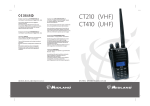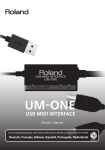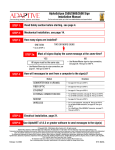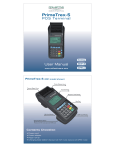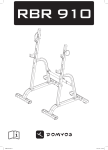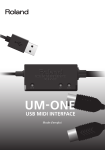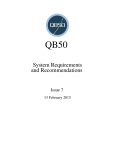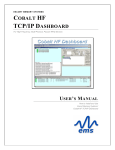Download Midland CT410 Troubleshooting guide
Transcript
0RODOTTOOIMPORTATODA#4%).4%2.!4)/.!,SRL 6IA23EVARDI-ANCASALE2EGGIO%MILIA)TALIA ,´USODIQUESTOAPPARATOPUwESSERESOGGETTOA RESTRIZIONINAZIONALI 0RIMADELL´USOLEGGEREATTENTAMENTELEISTRUZIONI 3EILPRODOTTOCONTIENEBATTERIENONGETTARENELFUOCO NONDISPERDERENELL´AMBIENTEDOPOL´USOUSAREGLI APPOSITICONTENITORIPERLARACCOLTA 0RODUCEDORIMPORTEDBY#4%).4%2.!4)/.!,SRL 6IA23EVARDI-ANCASALE2EGGIO%MILIA)TALY )MPORTEDBY!,!.5+ 5NIT#ALLENDERS0ADDINGTON$RIVE#HURCHWARD0ARK 3WINDON7ILTSHIRE3.975NITED+INGDOM 4HEUSEOFTHISTRANSCEIVERCANBESUBJECTTONATIONAL RESTRICTIONS 2EADTHEINSTRUCTIONSCAREFULLYBEFOREINSTALLATIONAND USE )FTHEPRODUCTCONTAINSDRYCELLSORRECHARGEABLE BATTERIESDONOTTHROWTHEBATTERIESINTOTHE½RE 4ODISPERSEAFTERUSETHROWINTOTHEAPPROPRIATE CONTAINERS )MPORTADOPOR!,!.#/--5.)#!4)/.3! ##OBALT#ORNELLgDE,LOBREGAT%SPAuA 4EL&AX 73ITEWWWMIDLANDES #4 5(& %LUSODEESTEEQUIPOPUEDEESTARSUJETOALAOBTENCIvN DELACORRESPONDIENTEAUTORIZACIvNADMINISTRATIVA !NTESDEUTILIZARLEAATENTAMENTEELMANUALDEUSO 3IELPRODUCTOCONTIENEPILASOBATERIASNOLASTIREAL FUEGONILASDISPERSEENELAMBIENTEDESPUmSDESUUSO UTILICELOSCONTENEDORESESPECIALESPARASURECOGIDA 6ERTRIEBDURCH!,!.%,%#42/.)#3'MB( $AIMLERSTRAE+$$REIEICH$EUTSCHLAND $IE"ENUTZUNGDIESES(ANDFUNKGERiTESISTVONDEN LANDESSPEZI½SCHEN"ESTIMMUNGENABHiNGIG 6OR"ENUTZUNG"EDIENUNGSANLEITUNGBEACHTEN"EI 6ERWENDUNGVON"ATTERIENBEACHTEN3IEBITTEDIE 5MWELTBESTIMMUNGEN "ATTERIENNIEMALSINSOFFENE&EUERWERFENUNDNURIN DAF~RVORGESEHENE3AMMELBEHiLTERENTSORGEN )MPORTmPAR!,!.&2!.#% 2UEDEL´)NDUSTRIE:)D´%PLUCHES3AINT/UEN ,´!UMONE&RANCE ,EPRODUITPEUToTRESUJETgRESTRICTIONSNATIONALES !VANTL´INSTALLATIONETL´UTILISATIONLISEZSVP SOIGNEUSEMENTLESINSTRUCTIONS 3ILEPRODUITCONTIENTDESBATTERIESOUDESBATTERIES RECHARGEABLESNELESJETERPASDANSLEFEU !PRESL´USAGEJETEZLESDANSLESRmCIPIENTSAPPROPRImS WWWMI DL AN DR ADI OEU \ #44RANSCEIVER Maintenance .......................................................................................................... 2 Features ................................................................................................................ 2 Main indicators/controls ......................................................................................... 3 LCD display ........................................................................................................... 5 Basic operations .................................................................................................... 6 Advanced operations ........................................................................................... 15 Menu operations Self-Programming mode...................................................................................... 17 Self-programming chart ....................................................................................... 18 Technical specifications ....................................................................................... 19 Troubleshooting guide ......................................................................................... 20 1 ENGLISH Contents ENGLISH Content • • • • • • 1 transceiver 1 antenna 1 battery pack 1 belt clip 1 fast desktop charger User manual If any items are missing, contact your dealer. Maintenance Your Two Way Radio is an electronic product of exact design and should be treated with care .The suggestions below will help you to fulfill any warranty obligations and to enjoy this product for many years. ▪ Do not attempt to open the unit. Non-expert handling of the unit may damage it. ▪ When using regulated power supply, take notice of power voltage that must be between 6V and 8V to avoid damaging the unit. ▪ Do not store the Radio under the sunshine or in hot areas. ▪ High temperatures can shorten the life of electronic devices, and warp or melt certain plastics. ▪ Do not store the radio in dusty, dirty areas ▪ Keep the Radio dry. Rainwater or damp will corrode electronic circuits. ▪ If it appears that the Radio diffuses peculiar smell or smoke, please shut off its power immediately and take off the charger or battery from the Radio. ▪ Do not transmit without antenna. Features ▪ 4W Output power (VHF/UHF) ▪ 128 groups of memory channels ▪ 25KHz/12.5KHz Channel spacing compatible ▪ Automatic Numbering Identification (ANI) code ▪ Built-in VOX function ▪ All channels scan and priority channel scan ▪ Scrambler ▪ LCD backlight adjustable in 3 different colours ▪ Emergency alarm ▪ 50 CTCSS and 104 DCS Normal/Inverted selectable ▪ Time-out Timer (TOT) ▪ Busy channel lockout 2 ENGLISH Main indicators/controls 1. Encoder 3. Power/Volume on-off 2. Antenna 4. Sending indicator 5. Speaker 6. Microphone 7. LCD 8. Function key 10. Enter key 12. Keypad Lock 9. Clear key 11. keypad 13. Reverse freq key 17. Battery release key 14. PTT key 15. Monitor key 16. Call key 18. Speaker/ microphone jack 19. Battery (Li-ion) 3 ENGLISH Main indicators/controls - description Power/volume on-off To turn on/off the radio and adjust the volume level. Busy indicator Press the PTT is pressed, it glows to indicate the transmitting status. When the channel is busy, the display shows PTT key When pressed, it enables the transmission. MONI (monitor) key Hold down this key in receiving mode: the channel in use will be monitored. The busy channel indicator will glow. Call key To call your partner Sending indicator To exit the menu and to switch from VFO to Memory mode. Socket and connector SMA Connector For connecting the supplied antenna Speaker/microphone jack If you want to use a speaker or a microphone, connect them to this socket. If not, prevent water from dropping into it. 4 Many icons are shown on the display when the radio is on. The following table can help you to identify each of them. Battery level indicator +// Shows the TX offset direction in relation to the RX frequency Power level indicator (HI=High/LO=Low) Frequency scanning indication Keypad lock Displays when DCS is turned on CT VOX CTCSS turned on VOX turned on Call Function R PRI Display reverse frequency Priority scan activated Received signal strength and TX power Frequency in use Function menu The scan finds a signal(open squelch) 5 ENGLISH LCD display ENGLISH Basic operations Supplied antenna Insert the base of the supplied antenna into the SMA connector and rotate it clockwise. Make sure the antenna has set down. Take out the antenna from the base by rotating it counterclockwise rotation. Turn on and off the power If you want to turn on the power, rotate the PWR/VOL knob clockwise until a beep is heard. All icons and frequencies appear on the screen. You can adjust your desired volume by turning the knob. To turn off the power, rotate the PWR/VOL knob counterclockwise rotation. All the icons on the display will disappear and the radio is off. Adjusting volume After turning on the radio, rotate the PWR/VOL knob clockwise to increase the volume and counter -clockwise to decrease. Transmitting/Receiving Firstly, hold down briefly the MONI button to make sure that the frequency is not busy and then press the PTT. Speak 4/10cm far from the unit. The TX indicator lights up. Release the PTT key to receive. Emergency Alarm Hold down the CALL key for 1 second and press MONI: the radio will switch to emergency alarm. Repeater tone When you press any key, a note at 1750Hz is generated. It gives the possibility to link to repeaters. Keypad Lock To Lock or unlock the buttons. In channel/Frequency mode, press and hold down the key for two seconds. The keypad will lock. Repeat the same procedure to unlock it. 6 ENGLISH Setting Reverse Frequency Function This function is possible only when you are linked to a repeater: it permits to invert the TX frequency with the RX frequency. for two seconds In Channel/Frequency mode, hold down until “R” appears on the display. Repeat the same procedure to return to the previous frequency setting. Scanning The Scan version is very useful to monitor the channels before transmitting. 1. Scan all the channels , , and In Channel/Frequency status, press , : the radio will scan from the channel in use through all the channels. Whenever any activity is detected, the radio will suspend the scan for 5 seconds. It will then key to end continue to scan unless you press PTT or scanning. 2. Priority channel scan , , and In Frequency Mode, press . The radio will scan from the current frequency through all the frequency range within 1MHz. Whenever any activity is detected, the radio will suspend the scan for 5 seconds. It will then continue to scan unless you press the PTT or key to end scanning. Select scan type In Frequency mode, press and rotate the Encoder until the and turn the Encoder display shows “SCAN 13”. Press knob again to select the scan type (TO/CO/SE). Confirm your selection with and exit by pressing twice. TO: Time-operated scan Even though the radio stops on a busy channel, it will continue scanning the other channels. CO: Carrier-operated scan The radio stops on a busy channel until there is no activity, and then radio begins scanning the other channels. SE: Search scan The radio stops on a busy channel and exits the Scan mode. 7 ENGLISH DTMF Code In Channel/Frequency mode, press PTT and digit a number on the keypad. Flank keys PTT: push to transmit and release it to receive PTT + CALL: push to enable a 1750Hz tone MONI: push it to monitor the frequency in use Select Mode Hold down and turn on the power: the radio can switch between the Channel and Frequency mode. Repeat the procedure to pass to the other mode. In Frequency mode, press to switch between the Frequency mode and Channel+Frequency mode. To store a frequency To store a frequency and its settings (CTCSS,DCS, SHIFT REPEATERS etc) follow the procedure below: 1. at first, choose all the settings to store, 2. press the button, , 3. then, push 4. rotate the Encoder knob and select the memory number where you want to store the frequency and its settings. 5. confirm your selection by pressing . (note: a triangle displayed underneath the channel number indicates that it has already been stored). 8 ENGLISH Delete a memory 1.Delete one stored channel Mode turn off the power. In key and turn on the unit. “DEL?” Hold down the and the stored channel number will be displayed. Turn the Encoder knob or select the channel to delete. Push until “YES?” appears on the display; push it again to confirm. 2. Reset (Delete all the settings in Frequency mode) Hold down the button and turn on the unit until “RESET?” is displayed. Press until “VFO?” is shown on the display; push it again for confirmation. 3. Delete all settings Hold down and turn on the unit until “VFO?” is shown on the display. Turn the Encoder knob to select “FULL?”, then press to delete all the settings in Frequency and VFO modes. 9 ENGLISH Advanced Operations Selecting the VOX sensitivity level The VOX function is deactivated by default. To activate it follow the procedure here below: 1. press the button; 2. turn the Encoder knob until the display shows ‘VOX’ (menu 03); 3. push the key; 4. turn again the Encoder knob and select the desired VOX level (you can choose amongst 9 different levels); 5. push the key again; 6. to exit, press twice . To activate and select rapidly the VOX function, you can do it also by operating on the fast menu: press the key and and follow the procedure above described starting then from point 3. Setting the transmission power To select the desired power level: 1. press the button; 2. turn the Encoder knob until ‘POW’ (menu 04) is displayed 3. push ; 4. turn the Encoder knob and select the desired power level (you can choose between 2 levels: ‘H’ ed ‘L’); 5. press ; 6. press twice the knob to exit. To activate and select rapidly the power level, you can also use the fast menu: press the key and then and follow the procedure above described starting from point 3. Setting squelch To select the squelch level: 1. press the button; 2. turn the Encoder knob until ‘SQL’ (menu 05) is displayed 3. push ; 4. turn the Encoder knob and select the desired squelch level (9 different levels are available); 5. press ; 6. press twice the knob to exit. To activate and select rapidly the squelch level, you can also 10 ENGLISH use the fast menu: press the key and then and follow the procedure above described starting from point 3. Scrambler on/off To activate the scrambler, follow this procedure: 1. press the button; 2. turn the Encoder knob until ‘SCRM’ (menu 06) is displayed 3. push ; 4. turn the Encoder knob and activate/deactivate the scrambler (ON = activated; OFF = deactivated); 5. press ; knob to exit. 6. press twice the To activate/deactivate rapidly this function, you can also use the fast menu: press the key and then and follow the procedure above described starting from point 3. Backlight on/off To select the LCD backlight: 1. press the button; 2. turn the Encoder knob until ‘LED’ (menu 07) is displayed 3. push ; 4. turn the Encoder knob and activate/deactivate the function: 3 different options are available (AUTO, ON, OFF); 5. press ; knob to exit. 6. press twice the To activate/deactivate rapidly the backlight, you can also use the fast menu: press the key and then and follow the procedure above described starting from point 3. Select the backlight colour To select the backlight colour: 1. press the button; 2. turn the Encoder knob until ‘LIGHT’ (menu 08) is displayed 3. push ; 4. turn the Encoder knob and choose the desired colour (3 different colours are available); 5. press ; knob to exit. 6. press twice the To select it rapidly, you can also use the fast menu: press 11 ENGLISH the key and then and follow the procedure above described starting from point 3. Beep on/off The keypad beep is activated by default. To deactivate it: button; 1. press the 2. turn the Encoder knob until ‘BEEP’ (menu 09) is displayed ; 3. push 4. turn the Encoder knob and activate/deactivate the beep (ON = beep enabled; OFF = beep disabled); ; 5. press 6. press twice the knob to exit. To activate/deactivate the keypad beep, you can use the key and then and follow the fast menu: press the procedure above described starting from point 3. Automatic Numbering Identification (ANI) on/off You can set an automatic number identifier visible from the radio’s display of your partner each time you send a call signal. To activate this function: button; 1. press the 2. turn the Encoder knob until ‘ANI’ (menu 10) is displayed; ; 3. press 4. rotate the Encoder knob and activate/deactivate the function. ON = activated, OFF = deactivated; again; 5. push 6. press twice to exit. To activate/deactivate the keypad beep, you can also use the key and then and follow the fast menu: press the procedure above described starting from point 3. Repeater shift (for communications through repeaters) To select this function, follow these steps: button; 1. press the 2. rotate the Encoder knob until ‘S-D’ (menu 19) is displayed; ; 3. press 4. turn the Encoder knob and select the repeater shift. You can choose amongst the following options +, - and 0; again; 5. press 6. press twice to exit 12 ENGLISH To select the repeater shift you can use the fast menu: press the key and then and follow the procedure above described starting from point 3. Repeater shift adjustment (for communications through repeaters) 1. press the button; 2. turn the Encoder knob until ‘DIFFR’ (menu 15) is displayed 3. push ; 4. turn the Encoder knob and select the repeater shift. You can also enable it by digiting the frequency directly on the keypad. 5. press ; Select the frequency step 1. press the button; 2. turn the Encoder knob until ‘STEP’ (menu 20) is displayed 3. push ; 4. turn the Encoder knob and select the desired frequency step. You can choose amongst: 5 KHz, 10 KHz, 6.25 KHz, 12.5 KHz and 25 KHz; 5. press twice the knob to exit Select the CTCSS and DCS tones To select a CTCSS tone 1. press the button; 2. turn the Encoder knob until ‘C-CDC’ (menu 16) is displayed 3. push ; 4. turn the Encoder knob and select the desired subaudio tone; 5. press to confirm. To select a DCS tone: 1. select ‘C-CDC’ (menu 16) either with the Encoder knob or with the fast access; 2. Press 3. Press the button; 4. turn the Encoder knob and select the desired DCS level; 5. press again for confirmation. 13 ENGLISH While selecting the DCS codes, if you press select the normal (N) or inverted (I) DCS codes. Voice function (only in English) , you will With this function, you activate a voice that informs about any operation/selection you are doing. To activate it, follow these steps: 1. press the button; 2. turn the Encoder knob until ‘VOICE’ (menu 14) is displayed; 3. push ; 4. turn the Encoder knob and activate/deactivate the function. (ON = enabled; OFF = disabled); again; 5. Push knob to exit. 6. press twice the 14 To operate with all the parts/settings of the menu, you have to follow these general steps: 1 Press the button. 2 Turn the Encoder knob to select the desired menu. 3 Press and turn the Encoder knob to choose the desired setting. 4 Press to confirm. Voice Menu Selection Operation scanning all the channels SCAN? 01 Scan entire channel to exit scan Press Press any key to return scanning within 1 MHz PRI? 02 Priority channel scan SAME AS ABOVE VOX activation and sensitivity VOX? 03 OFF-9 Turn encoder to select to confirm Press to exit Press power level selection POW? 04 H/L SAME AS ABOVE squelch selection SQL? 05 0-9 SAME AS ABOVE scrambler activation/ deactivation SCRM? 06 ON/OFF SAME AS ABOVE Backlight LED? 07 ON/OFF/AUTO SAME AS ABOVE colour of the LCD backlight LIGHT? 08 1/2/3 SAME AS ABOVE keypad beep BEEP? 09 ON/OFF SAME AS ABOVE automatic number identifier ANI? 10 ON/OFF SAME AS ABOVE keypad lock KEYBO? 11 MANUAL/AUT SAME AS ABOVE 15 ENGLISH Menu Operation ENGLISH time out transmission TOT? 12 OFF-270 SAME AS ABOVE type of scanning SCANS?13 TO/CO/SE Turn encoder to select Press to confirm to exit Press twice voice function activation VOICE?14 ON/OFF Turn encoder to select to confirm Press to exit Press shift repeater DIFFR? 15 0-70.995 Input frequency or turn encoder to confirm Press to exit Press ctcss/dcs rx/tx C-CDC? 16 See CTCSS chart SAME AS ABOVE ctcss/dcs only rx R-CDC? 17 See CTCSS chart Turn Encoder to select to confirm Press ctcss/dcs only rx T-CDC? 18 See CTCSS chart SAME AS ABOVE + / - shift S-d? 19 +/-/cancel Turn encoder to select to confirm Press to exit Press frequency step selection STEP? 20 5k/10k/6.25k/ 12.5k/25k SAME AS ABOVE wide/narrow band selection N/W ? 21 Wide Narrow SAME AS ABOVE Exit VFO/MR Note: parts from 16 to 21 are available only in Frequency mode. In Channel mode only parts from 1 to 15 are active. To pass rapidly from Frequency to Channel mode or vice versa, switch on the unit and hold down the button. NAME 16 ON/OFF Turn encoder to select to confirm Press to exit Press To enter in Self-Programming mode, follow these steps: 1. 2. 3. 4. 5. 6. 7. while turning on the unit, hold down ‘MONI’ and until ‘SELF’ is displayed; ; press turn the Encoder knob and select the memory number to program; again; push digit the desired rx frequency; ; press press and with the Encoder knob select the desired CTCSS in RX (if you press it again, you can select a DCS code); ; 8. press 9. digit the desired tx frequency; ; 10. push 11. press and with the Encoder knob select the desired CTCSS in TX (if you press it again, you can select a DCS code); ; 12. press 13. with the Encoder knob, enable/disable the busy channel lockout (you can choose: OFF, 1 carrier, 2 CTCSS/DCS); ; 14. press 15. by turning the Encoder knob, you can enable/disable the priority channel scanning; ; 16. press 17. turn the Encoder knob and select the power level in tx H (high) or L (low); ; 18. press 19. turn the Encoder knob and select the transmission mode: WIDE or NARROW; ; 20. push 21. rotate the Encoder knob and select the first letter for the name of the button programmed channel. To switch to the next channel, push the and turn the Encoder knob; ; 22. press 23. switch off the unit to finish the programming procedure and return to the standard modality. 17 ENGLISH Self-Programming mode ENGLISH Self-programming chart MONI+ + switch on the radio for 2 seconds Display example Self-programming Channels Encoder Select channel 1 to 128 Receiving frequency Encoder Select receiving frequency Receiving codes Encoder Select CTCSS / DCS Press *LOCK to switch Transmitting frequency Encoder Select transmitting frequency Transmitting codes Encoder Select CTCSS / DCS Press *LOCK to switch Busy channel Lockout Encoder OFF: close 1. Carrier 2.CTCSS/DCS Priority channel scan Encoder Add: Add priority - Channel scan Del: Delete priority Channel scan Output Power Encoder H: High power L: Low power Channel spacing Encoder WIDE: 25KHz NARROW: 12.5KHz Program CH name Encoder Press to confirm and switch to the next channel END 18 ENGLISH Technical specifications General Frequency Range Working Temperate Operating Voltage Operate Mode Dimension Weight Antenna impedance Duty cycle Transmitter Frequency Stability Output Power Max Frequency Deviation Audio Distortion Adjacent Channel Power Spurious Radiation Occupied Bandwidth Receiver RF Sensitivity Audio Distortion Audio Response Adjacent Channel Selectivity Intermodulation Rejection Spurious Response Blocking CT210: 144-146MHz; CT410: 430-440MHz -20°-+50° DC 7.4V Simplex or Semi-duplex 100mm×58mm×33mm (Antenna excluded) 203g (Including battery) 50Ω 5/5/90 ±2.5PPM ≤4W ≥5KHz ≤3% Within European legal terms Within European legal terms Within European legal terms <0.2μV ≤3% 300Hz ÷ 3KHz Within European legal terms Within European legal terms Within European legal terms Within European legal terms 19 ENGLISH Troubleshooting guide Problem Solution The battery pack may be dead. Recharge or replace it. No Power The battery pack may not be installed correctly. Remove it and install it again. Battery power dies The battery pack life is finished. shortly after charging Replace the battery pack with a new one. Make sure you are using the same frequency and CTCSS/DCS tone as the other members in your Cannot talk to or hear other members in your group. group Other group members may be too far away. Make sure you are within the range of the other radios. Change the CTCSS/DCS tone. Other voices (besides group members) are Be sure to change the tone on all radios in your present on the channel. group. 20 50 CTCSS codes CH 1 2 3 4 5 6 7 8 9 10 11 12 13 CTCSS 67 69,3 71,9 74,4 77,0 79,7 82,5 85,4 88,5 91,5 94,8 97,4 100,0 CH 14 15 16 17 18 19 20 21 22 23 24 25 26 CH 1 2 3 4 5 6 7 8 9 10 11 12 13 14 15 16 17 18 19 20 21 22 23 24 25 26 DCS 23 25 26 31 32 36 43 47 51 53 54 65 71 72 73 74 114 115 116 122 125 131 132 134 143 145 CH 27 28 29 30 31 32 33 34 35 36 37 38 39 40 41 42 43 44 45 46 47 48 49 50 51 52 CTCSS 103,5 107,2 110,9 114,8 118,8 123,0 127,3 131,8 136,5 141,3 146,2 151,4 156,7 CH 27 28 29 30 31 32 33 34 35 36 37 38 39 CTCSS 159,8 162,2 165,5 167,9 171,3 173,8 177,3 179,9 183,5 186,2 189,9 192,8 196,6 CH 40 41 42 43 44 45 46 47 48 49 50 CTCSS 199,5 203,5 206,5 210,7 218,1 225,7 229,1 233,6 241,8 250,3 254,1 CH 79 80 81 82 83 84 85 86 87 88 89 90 91 92 93 94 95 96 97 98 99 100 101 102 103 104 105 DCS 466 503 506 516 523 526 532 546 565 606 612 624 627 631 632 645 654 662 664 703 712 723 731 732 734 743 754 104+1 DCS codes DCS 152 155 156 162 165 172 174 205 212 223 225 226 243 244 245 246 251 252 255 261 263 265 266 271 274 306 CH 53 54 55 56 57 58 59 60 61 62 63 64 65 66 67 68 69 70 71 72 73 74 75 76 77 78 DCS 311 315 325 331 332 343 346 351 356 364 365 371 411 412 413 423 431 432 445 446 452 454 455 462 464 465






















